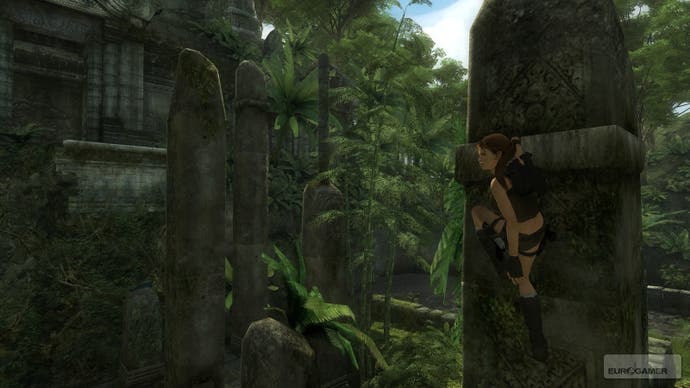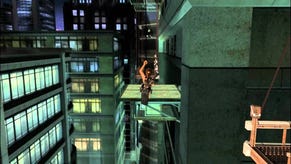Tomb Raider Underworld
Thai another day.
What follows is a careful mix of old and new, in the form of a quick clamber and hop from pillar to post to crumbling ledge to get inside the ancient ruin, while giving the local wildlife a hard time. Platforming looks as enjoyable as ever - few games can make the mundane task of jumping from one bit of scenery to another quite as satisfying as Tomb Raider does - and there's a gently evolved range of new acrobatics, such as wall jumps, which were cut from Legend. Astonishingly, this is also the first time Croft has been mo-capped, and it's a credit to the animators on the previous games that you can only very occasionally tell the difference.
The most striking development is that Croft can now shoot while otherwise engaged - clambering along ledges or hanging from those odd poles that seem to be such a feature of temple design whenever Eidos is involved. This gives the developers a lot more scope to mix up running and gunning compared to the fire-fights of the previous titles, where the simplistic AI and limited targeting options meant that your best strategy was almost always to run in a circle shooting backwards (which says Benny Hill more than Indiana Jones), or clambering onto a rock which enemies were too stupid to get onto as well.
With no human enemies on hand in the demo, it's impossible to tell whether their AI has been improved, so Croft is left to contend with the regular motley assortment of endangered species. Even here there are slight tweaks, with the addition of a tranquiliser gun to pacify both the lions and the animal cruelty lobbyists (who will hopefully turn up as last stage boss encounters), and lizards who can scale walls and drop down from above.

Combat aside and temple breached, all that's left is an elaborate puzzle - a multi-armed god statue (if I was smarter, or if the lights hadn't been so dimmed in the preview room and I was able to re-read my own notes, I'd know the name of this particular deity - I think it's Shiva), which has to be carefully manipulated by finding various objects around the temple and wedging them into the correct sockets. Business as usual, in other words.
At moments like this, there's always been a slight danger that Tomb Raider might turn into an exotically-styled postman simulator, but despite the necessary trinkets being located all over the sprawling temple, the game seems to offer variety in the way they can be collected - setting up a pattern with one piece, altering it, often rather nastily, with a second. This is Anniversary-style play rather than the speed-running of Legend, then, but it's folded into the level with skill, wit, ingenuity, and a minimum of backtracking. And Croft's far more dextrous when carrying objects now - able to take out a lion while carrying a staff, and then insert the staff into a rather convenient gap in a wall to propel herself to higher ground.

It seems schizophrenic to demand sweeping change from some games while preferring others to evolve more cautiously, but Tomb Raider has had a major reboot relatively recently, and the core elements - not just the platforming and the graceful animation, but the seductive isolation of the environments and the genuine sense of adventure the game exudes - mean that this kind of educated refinement to the series seems strangely appropriate.
There's still no real excuse for the clumsy gunplay, but even with titles as accomplished as Uncharted: Drake's Fortune looking to move in on Croft's territory, Tomb Raider's lonely take on exploration remains an agenda that separates it from almost every other adventure game. The marketing may play to the likes of Zoo and Nuts, but the core experience is often thoughtful, peaceful, and surprisingly devious. From what we've seen, Underworld is building on that precious framework in careful increments.



